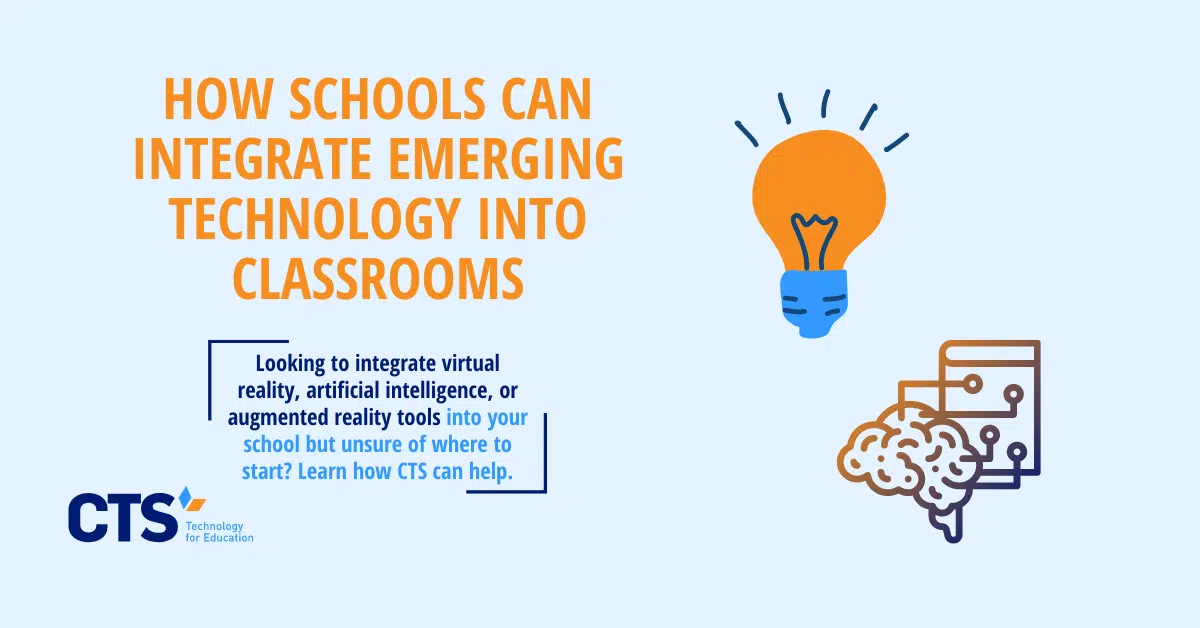Educators are finding ways to integrate emerging technology like virtual reality (VR), artificial intelligence (AI), and augmented reality (AR) into the classroom.
Emerging technology has always found its way into schools that are looking for innovative ways to support student learning. Laptops for students started off as shared resources in a limited number of schools and have since proliferated to the point where walking into any classroom in the country, you are very likely to see students with their own devices. As certain types of technology – like laptops, tablets, and SmartBoards – become commonplace, K-12 educators are seeing new technological offerings become available in the marketplace and they are wondering how they can integrate these new tools into the classroom to support student learning.
Virtual reality learning experiences are on the rise.
Educators are using VR platforms to provide incredible experiences to students. Through VR trips, schools can take students on field trips that increase their learning through experiences that would have otherwise been inaccessible. Instead of learning about evolution and natural selection through direct instruction, readings, and photographs only, students can put on a VR headset and visit multiple Galapagos Islands. They can explore the various islands and see for themselves why those environments are well-suited for evolution.
While learning about U.S. geography, students can explore states across the country without having to ride a bus or board a plane. They can visit multiple locations in one afternoon, take note of their observations, and have conversations in the classroom to discuss what they’ve seen.
VR is expanding the options for science education. Platforms that provide science simulations and virtual labs, like Labster, offer opportunities for students to participate in lab experiments that might otherwise be too costly or too dangerous. The use of this emerging technology in classrooms can have a real impact on student learning and on student interest in science – helping to increase the number of students who are interested in entering the STEM field.
Schools will need to invest in VR hardware but there are many organizations that provide free or low-cost software or platform options for field trips and other immersive learning experiences.
Artificial intelligence is another type of emerging technology that is making its way into classrooms.
Providing students with individualized and differentiated learning experiences is a goal of many educators that is difficult to achieve in classrooms that sometimes have 30 or more students. Educators have been using online learning platforms to make this personalization possible for a long time. However, newly released options for emerging technology – that are specifically tailored for schools – are available to support that personalization on a deeper level.
Google for Education has recently launched tools that apply advanced artificial intelligence and machine learning to adaptive learning models. This use of emerging technology can gather insights into a student’s learning patterns and processes and provide personal feedback in a manner that is immediate. AI even provides students with pop-up messages of support and encouragement at the right time, in the moments when they are struggling, to help them remain motivated.
Teachers are using augmented reality learning experiences to make their classrooms more interactive and hands-on.
Educators are using AR technology to superimpose graphics, videos, and sounds onto their existing classroom environments. Through the use of these tools, students are having experiences as diverse as practicing their handwriting or interacting with sea creatures that live on the ocean floor. They can virtually hold objects or artifacts in their hand. Students can move these objects and artifacts around, they can manipulate them, or bring them closer or further away to better their understanding. They can even put on character masks to experience a different perspective like that of a character in a story or an animal. These exciting additions to the options for instruction boost student engagement and deepen their understanding.
At CTS, we support schools as they work to integrate emerging technology into the classroom.
Paying attention to trends in emerging technology and then deciding which options best suit a school’s unique mission takes time and we know that time is an extremely limited resource for today’s school leaders. Our goal is to take the lead on this effort so that school leaders can focus on the needs of their teachers, their students, and their school’s mission.
We support schools with sourcing and procurement for virtual reality, artificial intelligence, and augmented reality tools and technologies. We can handle the hardware and software purchasing and support staff with training so they can make good use of the technology in pursuit of better student engagement and increased achievement. If you are interested in learning more about the availability of emerging technology and how implementation can benefit your students, we can help. Contact us today to learn more about our services and how we can help your school accomplish its unique mission.




